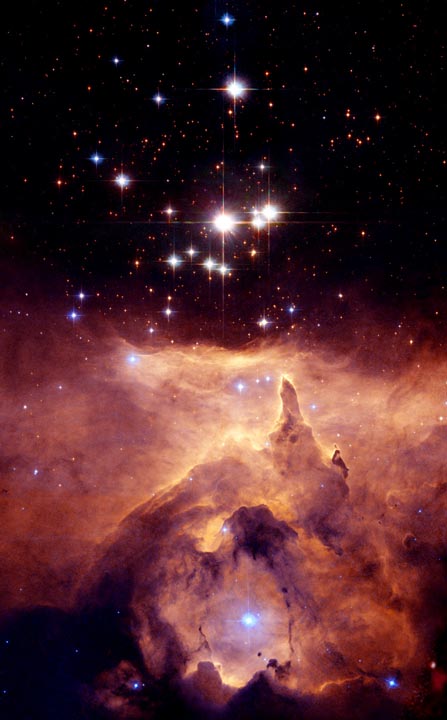
Description: Open Star Cluster and Emission Nebula
Position (J2000): R.A. 17h 25m 24s.00 Dec. -34° 26' 0."0
Constellation: Scorpius
Distance: About 8,000 light-years (2,500 parsecs)
Dimensions: The width is 2.4 arcminutes (6 light-years or 1.75 parsecs).
Instrument: ACS/WFC, ACS/HRC, WFPC2
Exposure Date(s): April 2002 and April 2006
Image Credit: NASA, ESA, and J. Maíz Apellániz
Instituto de Astrofísica de Andalucía, Spain
Release Date: December 11, 2006
Related images: N1309 S1015 S0654 N1226 N1612
ABOUT THIS IMAGE:
The small open star cluster Pismis 24, about 8,000 light years away, lies in the core of the large emission nebula NGC 6357 in the constellation of Scorpius, that extends one degree in the sky. Part of the nebula is ionized by the youngest (bluest) heavy stars in Pismis 24. The intense ultraviolet radiation from the blazing stars heats the gas surrounding the cluster and creates a bubble in NGC 6357.
High-resolution observations from Hubble have shed light on the real mass of a star previously believed to be amongst the heaviest known in our Milky Way. Originally, the mass of the star was thought to be an incredible 200-300 solar masses, but turned out to be only 100 solar masses.
How heavy can a star be? This conundrum has haunted astronomers for decades. Theory indicates that there should be an upper stellar mass limit somewhere between 120 and 300 solar masses. Even though heavy stars are very bright, measurements of their masses can be complicated. The majority of the heaviest stars - some researchers say as many as 90% or maybe even more - tend to be born in multiple systems that can easily disguise themselves as single very heavy stars. Moreover, these stellar heavyweights are so rare that only a few are close enough to the Sun to be examined in detail.
One of the top candidates for the title of "Milky Way stellar heavyweight champion" was, until now, Pismis 24-1, a bright young star that lies in the core of the small open star cluster Pismis 24. Pismis 24-1 was once thought to weigh as much as 200 to 300 solar masses. This would have made it by far the most massive known star in the Milky Way. However, Hubble Space Telescope high-resolution images of the star show that it is really two stars orbiting one another. They are estimated to each be 100 solar masses.
In addition, spectroscopic observations with ground-based telescopes further reveal that one of the stars is actually a tight binary that is too compact to be resolved even by Hubble. This divides the estimated mass for Pismis 24-1 among the three stars. Although the stars are still among the heaviest known, the mass limit has not been broken thanks to the multiplicity of the system.
The observations were performed by a team of astronomers led by J. Maíz Apellániz of the Instituto de Astrofísica de Andalucía in Spain. The team imaged Pismis 24-1 with Hubble's Advanced Camera for Surveys in April 2006. The images of NGC 6357 were taken with Hubble's Wide Field and Planetary Camera 2 in April 2002.
The team also managed to determine the mass of another massive star in Pismis 24: Pismis 24-17. Its mass is around 100 times that of our Sun and brings the total number of heavy stars within this cluster to at least three, which is a very rare occurrence for a cluster this small: In our Milky Way, for every star with 65 solar masses or more that is born, another 18,000 solar-mass stars are produced. Furthermore, since a 65 solar-mass star lives for only 3 million years while a solar mass star can live for more than 3,000 times that long, there are actually millions of solar-mass stars for each very massive star.
Pismis 24-1's "weight loss" may continue in the future: ground-based observations indicate that Pismis 24-1 could even be a triple star system. Although each of the three stars would then only average 70 solar masses, they would still make it to the top twenty-five for "Milky Way heavyweights", but only for a few million years as they would be sure to end their lives as supernovae and then turn into black holes.
Jesús Maíz Apellániz's team plans to study the Pismis 24 cluster further and to look at other systems in the hope of establishing just how massive a star can be. Massive stars can be the precursors of either black holes or neutron stars, formed in the supernovae that are the final spectacular flaring of a collapsing massive star and the main sources of the heavy elements in the Universe. By studying massive stars astronomers gain a deeper insight into our current understanding of black holes, supernova explosions and the chemical composition of the Universe.
Color:
This image is a composite of many separate exposures made by the ACS and WFPC2 instruments on the Hubble Space Telescope using several different filters. Five filters were used to sample both broad and narrow wavelength ranges. The color results from assigning different hues (colors) to each monochromatic image. In this case, the assigned colors are:
Blue: F550W (V) + F547M (Strömgren y) Red: F656N (Halpha) + F658N (Halpha+[N II]) + F850LP (SDSS i)